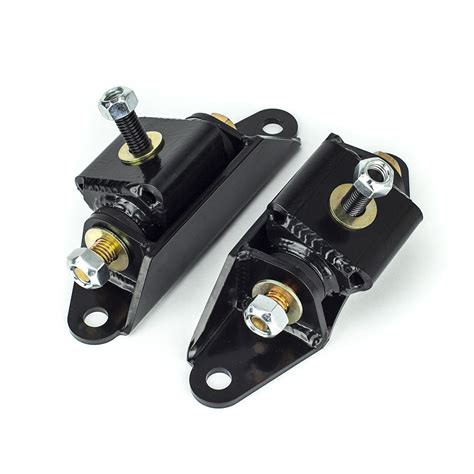Discover the benefits and drawbacks of solid engine mounts, their performance impact, installation tips, and how they compare to traditional mounts.When it comes to enhancing automotive performance, the choice of engine mounts plays a crucial role, and solid engine mounts have emerged as a popular option among performance enthusiasts. Unlike traditional mounts that use rubber or hydraulic materials, solid engine mounts consist of rigid materials designed to minimize engine movement and improve power transfer to the drivetrain. In this blog post, we’ll explore what solid engine mounts are, their pros and cons, and how they impact overall vehicle performance. We’ll also provide insights into the installation process and compare them with traditional engine mounts to help you make an informed decision about your vehicle’s needs. Whether you’re a seasoned racer or a casual driver seeking better handling, understanding solid engine mounts is key to unlocking your car’s true potential.
What are solid engine mounts?
In the realm of automotive engineering, solid engine mounts are pivotal components that serve a critical role in the mounting and support system of an engine, designed to secure the engine to the vehicle’s chassis and reduce the movement of the engine during operation.
Unlike traditional engine mounts, which typically utilize rubber or polyurethane materials to absorb engine vibrations and isolate them from the vehicle’s cabin, solid engine mounts are made from either metals or rigid composite materials, providing a more direct connection between the engine and the chassis.
This inherent rigidity of solid engine mounts contributes to a number of mechanical advantages, as they facilitate improved performance by maintaining precise alignment of the engine under harsh driving conditions, while also preventing unwanted engine movement that can lead to misalignment of drivetrain components.
Furthermore, solid engine mounts are often preferred in high-performance applications, where the goal is to maximize power transfer and minimize flex, thereby ensuring that the engine’s power is effectively transmitted to the wheels without the damping effects often experienced with softer mounts.
In essence, these mounts help in the optimization of a vehicle’s performance, although they may introduce a certain level of increased vibration felt within the cabin, which is an acceptable trade-off for those who prioritize acceleration and handling over ride comfort.
Pros and cons of solid engine mounts
When it comes to automotive modifications, the choice of solid engine mounts is often a debated topic among car enthusiasts, as they offer a very distinctive set of advantages and disadvantages that can significantly affect the vehicle’s performance and comfort.
On the one hand, one of the biggest pros of utilizing solid engine mounts is that they provide superior stability; this stability allows for enhanced energy transfer from the engine to the chassis, which can translate into improved responsiveness during acceleration and handling, particularly during high-performance driving or racing scenarios, where precise control is paramount. Additionally, solid engine mounts typically reduce unwanted motor movement, which further contributes to increased overall performance by minimizing drivetrain flex, thus enabling more direct power delivery.
However, it is essential to weigh these benefits against the cons associated with solid engine mounts, as they can lead to greater vibration and noise inside the vehicle cabin, which often compromises the driving experience for everyday use. The increased rigidity can also impose additional stress on other components of the vehicle, leading to potential wear and tear over time, making it crucial for owners to consider their driving style and intended use before implementing these modifications.
Impact of solid engine mounts on performance
When discussing the impact of solid engine mounts on vehicle performance, it is vital to understand that these mounts play a crucial role in maintaining engine stability, reducing unwanted vibrations, and enhancing overall responsiveness during driving, thereby allowing the driver to experience a more direct connection with the road and improved handling characteristics that are particularly sought after by enthusiasts.
One of the significant advantages associated with solid engine mounts is their ability to significantly reduce the degree of engine movement, which not only translates to a more efficient power transfer to the drivetrain but also limits the wear and tear on other components such as the transmission and exhaust system, making them a favorable choice for performance-focused applications where every aspect of responsiveness and reliability counts.
However, it is equally important to consider some potential downsides as well; while solid engine mounts can enhance performance, they may also lead to increased levels of cabin noise and vibration, which can detract from comfort during daily driving, making it essential for car owners to weigh these factors carefully and decide whether the performance benefits outweigh any possible sacrifices in comfort and drivability.
Installation of solid engine mounts
Installing solid engine mounts requires careful consideration and precise execution, as the process involves several critical steps that ensure the effective performance of your vehicle while maintaining optimum safety and reliability. One of the first steps in the installation process is to gather all necessary tools and equipment, which typically includes wrenches, sockets, a jack, jack stands, and potentially a torque wrench to ensure that all fasteners are tightened to the manufacturer’s specifications. Additionally, before beginning the installation, it is essential to ensure that the vehicle is parked on a level surface and that the engine is cool to the touch to avoid any injuries or mishaps during the process.
Once you have everything ready, the next step involves lifting the vehicle securely with the jack and supporting it with jack stands, allowing you to access the engine compartment effectively. After securing the vehicle, it is advisable to disconnect the battery to prevent any electrical issues while working in the engine bay. Subsequently, you will need to locate the existing engine mounts and remove them carefully, often requiring that you support the engine with a jack or engine hoist to prevent it from dropping unexpectedly. During this phase, you should also take note of the orientation and positioning of the original mounts, as they will act as a reference for installing the new solid engine mounts.
After the old mounts are removed, you’ll want to clean the mounting surfaces thoroughly to ensure a solid bond between the engine and the new mounts, and this is where using a wire brush or a scraper can be particularly effective. As you install the solid engine mounts, it is vital to align them correctly and to hand-tighten the bolts before finally torqueing them to the specified levels laid out in the vehicle’s service manual, thus ensuring that your engine is securely fastened while also allowing for proper vibration absorption. In conclusion, while the installation of solid engine mounts can be a demanding task, following these steps methodically will help ensure that the job is completed correctly and that your vehicle benefits from improved performance and enhanced stability on the road.
Comparison with traditional engine mounts
When examining the differences between solid engine mounts and traditional engine mounts, one must recognize that the two types serve the same fundamental purpose of securing the engine to the vehicle’s chassis, yet they employ vastly different methodologies that yield distinct outcomes in performance and comfort. Traditional engine mounts, often constructed from rubber or a combination of rubber and liquid-filled materials, are designed to absorb vibrations, isolating the engine’s harshness from the car’s cabin and allowing for a smoother ride experience, whereas solid engine mounts, as the name suggests, are made of solid materials that provide a rigid connection between the engine and the body of the vehicle, ensuring that engine movement is minimized to an absolute minimum for improved performance.
The benefits of using solid engine mounts can be quite impressive; they reduce engine movement significantly, which can enhance throttle response and improve power delivery during acceleration, leading to a more engaging driving experience overall. Conversely, traditional engine mounts can lead to a greater degree of flexibility, which, while it enhances comfort and reduces noise, may also result in sluggish engine response and less precise handling, especially in performance applications. It’s essential for car enthusiasts and those seeking to enhance performance to consider how the choice of mounts affects not only the car’s dynamics but also its overall character—an aspect that is often overlooked in everyday driving.
In terms of durability, another striking disparity exists: while solid engine mounts typically offer superior longevity due to their robust construction, traditional engine mounts may suffer from wear and tear over time, especially in environments with extreme temperatures or heavy driving conditions. The decision between these two types of mounts should therefore involve a careful consideration of driving habits, the intended use of the vehicle, and the desired balance between comfort and performance, ultimately leading one to weigh the advantages of each option carefully to determine which aligns best with their automotive needs.
Frequently Asked Questions
What are solid engine mounts?
Solid engine mounts are rigid components that secure the engine to the vehicle’s chassis, minimizing movement and improving performance.
What are the benefits of using solid engine mounts?
The benefits include enhanced stability, improved throttle response, reduced engine movement, and better handling during performance driving.
What are the disadvantages of solid engine mounts?
Disadvantages may include increased cabin vibrations, noise, and potential discomfort during daily driving compared to softer, stock mounts.
How do solid engine mounts affect vehicle performance?
They improve power transfer to the wheels by reducing engine movement, which can lead to more precise handling and quicker acceleration.
Are solid engine mounts suitable for daily drivers?
While they can be used in daily drivers, they may lead to a harsher ride and increased noise, making them less comfortable for some users.
How do I know if I need to replace my engine mounts with solid ones?
Consider upgrading if you experience excessive engine movement, participate in performance driving, or are upgrading other engine components.
Can I install solid engine mounts myself?
Yes, if you have basic mechanical skills and tools, you can install them yourself, but it’s advisable to consult a professional if you’re unsure.





